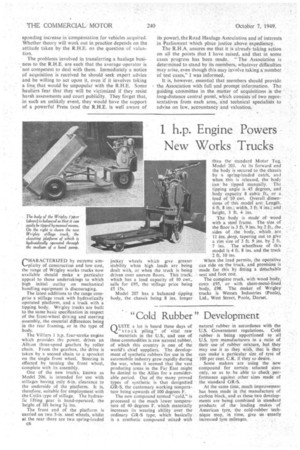"Cold Rubber ) . 1
Page 44

If you've noticed an error in this article please click here to report it so we can fix it.
Development
r\UITE a lot is heard these days of
stock piling" of vital raw materials in the U.S., and one of these commodities is raw natural rubber, of which this country is one of the world's chief suppliers. The development of synthetic rubbers for use in the automobile industry grew rapidly during the war, when it seemed that the vast producing areas in the Far East might be denied to the Allies for a consider7 able period. Out of the many proved types of synthetic is that designated .G1t-S, the customary working tempera ture being upwards of 100 degrees F.
The new compound termed "cold," is. processed at the much lower temperature of 40 degrees F. which materially increases its wearing ability over the ordinary OR-S type, which basically is a synthetic compound mixed with natural rubber in accordance with the U.S. Government regulations. Cold rubber is being apportioned to all U.S. tyre manufacturers in a ratio of their use of rubber mixture, but they may use it as they wish, that is they can make a particular size of tyre of 100 per cent. C.R. if they so desire.
Some makers are using the new compound for certain selected sizes only, so as to be able to check performance against other sizes made of the standard GR-S.
At the same time, much improvement has been made in the manufacture of carbon black, and as these two developments are being combined in standard products of the leading makes of American tyre, the cold-rubber 'technique may, in time, give us greatly increased tyre mileages.




































































































